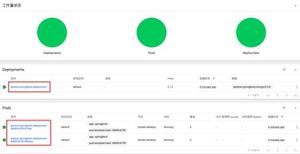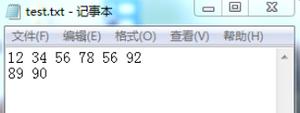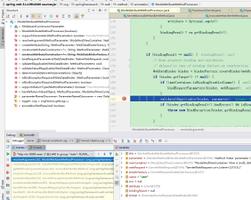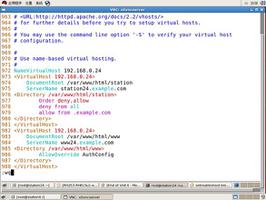Java如何使用interrupt()终止线程
一、interrupt() 说明
interrupt()的作用是中断本线程。
本线程中断自己是被允许的;其它线程调用本线程的interrupt()方法时,会通过checkAccess()检查权限。这有可能抛出SecurityException异常。
如果本线程是处于阻塞状态:调用线程的wait(), wait(long)或wait(long, int)会让它进入等待(阻塞)状态,或者调用线程的join(), join(long), join(long, int), sleep(long), sleep(long, int)也会让它进入阻塞状态。若线程在阻塞状态时,调用了它的interrupt()方法,那么它的“中断状态”会被清除并且会收到一个InterruptedException异常。例如,线程通过wait()进入阻塞状态,此时通过interrupt()中断该线程;调用interrupt()会立即将线程的中断标记设为“true”,但是由于线程处于阻塞状态,所以该“中断标记”会立即被清除为“false”,同时,会产生一个InterruptedException的异常。
如果线程被阻塞在一个Selector选择器中,那么通过interrupt()中断它时;线程的中断标记会被设置为true,并且它会立即从选择操作中返回。
如果不属于前面所说的情况,那么通过interrupt()中断线程时,它的中断标记会被设置为“true”。
中断一个“已终止的线程”不会产生任何操作。
二、终止线程的方式
Thread中的stop()和suspend()方法,由于固有的不安全性,已经建议不再使用!
下面,我先分别讨论线程在“阻塞状态”和“运行状态”的终止方式,然后再总结出一个通用的方式。
1、终止处于“阻塞状态”的线程
通常,我们通过“中断”方式终止处于“阻塞状态”的线程。
当线程由于被调用了sleep(), wait(), join()等方法而进入阻塞状态;若此时调用线程的interrupt()将线程的中断标记设为true。由于处于阻塞状态,中断标记会被清除,同时产生一个InterruptedException异常。将InterruptedException放在适当的位置就能终止线程,形式如下:
@Override
public void run() {
try {
while (true) {
// 执行任务...
}
} catch (InterruptedException ie) {
// 由于产生InterruptedException异常,退出while(true)循环,线程终止!
}
}
说明:在while(true)中不断的执行任务,当线程处于阻塞状态时,调用线程的interrupt()产生InterruptedException中断。中断的捕获在while(true)之外,这样就退出了while(true)循环!
注意:对InterruptedException的捕获务一般放在while(true)循环体的外面,这样,在产生异常时就退出了while(true)循环。否则,InterruptedException在while(true)循环体之内,就需要额外的添加退出处理。形式如下:
@Override
public void run() {
while (true) {
try {
// 执行任务...
} catch (InterruptedException ie) {
// InterruptedException在while(true)循环体内。
// 当线程产生了InterruptedException异常时,while(true)仍能继续运行!需要手动退出
break;
}
}
}
说明:上面的InterruptedException异常的捕获在whle(true)之内。当产生InterruptedException异常时,被catch处理之外,仍然在while(true)循环体内;要退出while(true)循环体,需要额外的执行退出while(true)的操作。
2、终止处于“运行状态”的线程
通常,我们通过“标记”方式终止处于“运行状态”的线程。其中,包括“中断标记”和“额外添加标记”。
(1)通过“中断标记”终止线程
形式如下:
@Override
public void run() {
while (!isInterrupted()) {
// 执行任务...
}
}
说明:isInterrupted()是判断线程的中断标记是不是为true。当线程处于运行状态,并且我们需要终止它时,可以调用线程的interrupt()方法,使用线程的中断标记为true,即isInterrupted()会返回true。此时,就会退出while循环。
注意:interrupt()并不会终止处于“运行状态”的线程!它会将线程的中断标记设为true。
(2)通过“额外添加标记”。
形式如下:
private volatile boolean flag= true;
protected void stopTask() {
flag = false;
}
@Override
public void run() {
while (flag) {
// 执行任务...
}
}
说明:线程中有一个flag标记,它的默认值是true;并且我们提供stopTask()来设置flag标记。当我们需要终止该线程时,调用该线程的stopTask()方法就可以让线程退出while循环。
注意:将flag定义为volatile类型,是为了保证flag的可见性。即其它线程通过stopTask()修改了flag之后,本线程能看到修改后的flag的值。
综合线程处于“阻塞状态”和“运行状态”的终止方式,比较通用的终止线程的形式如下:
@Override
public void run() {
try {
// 1. isInterrupted()保证,只要中断标记为true就终止线程。
while (!isInterrupted()) {
// 执行任务...
}
} catch (InterruptedException ie) {
// 2. InterruptedException异常保证,当InterruptedException异常产生时,线程被终止。
}
}
三、终止线程的示例
interrupt()常常被用来终止“阻塞状态”线程。参考下面示例:
package com.demo.interrupt;
public class MyThread extends Thread{
public MyThread(String name) {
super(name);
}
@Override
public void run() {
try {
int i=0;
while (!isInterrupted()) {
Thread.sleep(100); // 休眠100ms
i++;
System.out.println(Thread.currentThread().getName()+" ("+this.getState()+") loop " + i);
}
} catch (InterruptedException e) {
System.out.println(Thread.currentThread().getName() +" ("+this.getState()+") catch InterruptedException.");
}
}
}
package com.demo.interrupt;
public class Demo1 {
public static void main(String[] args) {
try {
Thread t1 = new MyThread("t1"); // 新建“线程t1”
System.out.println(t1.getName() +" ("+t1.getState()+") is new.");
t1.start(); // 启动“线程t1”
System.out.println(t1.getName() +" ("+t1.getState()+") is started.");
// 主线程休眠300ms,然后主线程给t1发“中断”指令。
Thread.sleep(300);
t1.interrupt();
System.out.println(t1.getName() +" ("+t1.getState()+") is interrupted.");
// 主线程休眠300ms,然后查看t1的状态。
Thread.sleep(300);
System.out.println(t1.getName() +" ("+t1.getState()+") is interrupted now.");
} catch (InterruptedException e) {
e.printStackTrace();
}
}
}
运行结果:
t1 (NEW) is new.
t1 (RUNNABLE) is started.
t1 (RUNNABLE) loop 1
t1 (RUNNABLE) loop 2
t1 (TIMED_WAITING) is interrupted.
t1 (RUNNABLE) catch InterruptedException.
t1 (TERMINATED) is interrupted now.
结果说明:
(01) 主线程main中通过new MyThread("t1")创建线程t1,之后通过t1.start()启动线程t1。
(02) t1启动之后,会不断的检查它的中断标记,如果中断标记为“false”,则休眠100ms。
(03) t1休眠之后,会切换到主线程main;主线程再次运行时,会执行t1.interrupt()中断线程t1。t1收到中断指令之后,会将t1的中断标记设置“false”,而且会抛出InterruptedException异常。在t1的run()方法中,是在循环体while之外捕获的异常;因此循环被终止。
我们对上面的结果进行小小的修改,将run()方法中捕获InterruptedException异常的代码块移到while循环体内。
package com.demo.interrupt;
public class MyThread extends Thread{
public MyThread(String name) {
super(name);
}
@Override
public void run() {
int i=0;
while (!isInterrupted()) {
try {
Thread.sleep(100); // 休眠100ms
} catch (InterruptedException ie) {
System.out.println(Thread.currentThread().getName() +" ("+this.getState()+") catch InterruptedException.");
}
i++;
System.out.println(Thread.currentThread().getName()+" ("+this.getState()+") loop " + i);
}
}
}
package com.demo.interrupt;
public class Demo2 {
public static void main(String[] args) {
try {
Thread t1 = new MyThread("t1"); // 新建“线程t1”
System.out.println(t1.getName() +" ("+t1.getState()+") is new.");
t1.start();// 启动“线程t1”
System.out.println(t1.getName() +" ("+t1.getState()+") is started.");
// 主线程休眠300ms,然后主线程给t1发“中断”指令。
Thread.sleep(300);
t1.interrupt();
System.out.println(t1.getName() +" ("+t1.getState()+") is interrupted.");
// 主线程休眠300ms,然后查看t1的状态。
Thread.sleep(300);
System.out.println(t1.getName() +" ("+t1.getState()+") is interrupted now.");
} catch (InterruptedException e) {
e.printStackTrace();
}
}
}
运行结果:
t1 (NEW) is new.
t1 (RUNNABLE) is started.
t1 (RUNNABLE) loop 1
t1 (RUNNABLE) loop 2
t1 (TIMED_WAITING) is interrupted.
t1 (RUNNABLE) catch InterruptedException.
t1 (RUNNABLE) loop 3
t1 (RUNNABLE) loop 4
t1 (RUNNABLE) loop 5
t1 (TIMED_WAITING) is interrupted now.
t1 (RUNNABLE) loop 6
t1 (RUNNABLE) loop 7
t1 (RUNNABLE) loop 8
t1 (RUNNABLE) loop 9
....
结果说明:
程序进入了死循环!
为什么会这样呢?这是因为,t1在“等待(阻塞)状态”时,被interrupt()中断;此时,会清除中断标记[即isInterrupted()会返回false],而且会抛出InterruptedException异常[该异常在while循环体内被捕获]。因此,t1理所当然的会进入死循环了。
解决该问题,需要我们在捕获异常时,额外的进行退出while循环的处理。例如,在MyThread的catch(InterruptedException)中添加break 或 return就能解决该问题。
下面是通过“额外添加标记”的方式终止“状态状态”的线程的示例:
package com.demo.interrupt;
public class MyThread extends Thread {
private volatile boolean flag= true;
public void stopTask() {
flag = false;
}
public MyThread(String name) {
super(name);
}
@Override
public void run() {
synchronized(this) {
try {
int i=0;
while (flag) {
Thread.sleep(100); // 休眠100ms
i++;
System.out.println(Thread.currentThread().getName()+" ("+this.getState()+") loop " + i);
}
} catch (InterruptedException ie) {
System.out.println(Thread.currentThread().getName() +" ("+this.getState()+") catch InterruptedException.");
}
}
}
}
package com.demo.interrupt;
public class Demo3 {
public static void main(String[] args) {
try {
MyThread t1 = new MyThread("t1"); // 新建“线程t1”
System.out.println(t1.getName() +" ("+t1.getState()+") is new.");
t1.start(); // 启动“线程t1”
System.out.println(t1.getName() +" ("+t1.getState()+") is started.");
// 主线程休眠300ms,然后主线程给t1发“中断”指令。
Thread.sleep(300);
t1.stopTask();
System.out.println(t1.getName() +" ("+t1.getState()+") is interrupted.");
// 主线程休眠300ms,然后查看t1的状态。
Thread.sleep(300);
System.out.println(t1.getName() +" ("+t1.getState()+") is interrupted now.");
} catch (InterruptedException e) {
e.printStackTrace();
}
}
}
运行结果:
t1 (NEW) is new.
t1 (RUNNABLE) is started.
t1 (RUNNABLE) loop 1
t1 (RUNNABLE) loop 2
t1 (RUNNABLE) is interrupted.
t1 (RUNNABLE) loop 3
t1 (TERMINATED) is interrupted now.
四、interrupt() 和 isInterrupted()的区别
最后谈谈 interrupt() 和 isInterrupted()。interrupt() 和 isInterrupted()都能够用于检测对象的“中断标记”。区别是,interrupt()除了返回中断标记之外,它还会清除中断标记(即将中断标记设为false);而isInterrupted()仅仅返回中断标记。
以上是 Java如何使用interrupt()终止线程 的全部内容, 来源链接: utcz.com/z/312062.html









